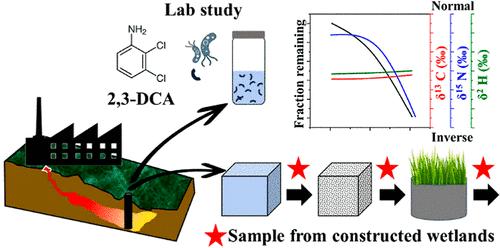当前位置:
X-MOL 学术
›
Environ. Sci. Technol.
›
论文详情
Our official English website, www.x-mol.net, welcomes your feedback! (Note: you will need to create a separate account there.)
Compound-Specific Carbon, Nitrogen, and Hydrogen Isotope Analysis to Characterize Aerobic Biodegradation of 2,3-Dichloroaniline by a Mixed Enrichment Culture
Environmental Science & Technology ( IF 10.8 ) Pub Date : 2024-06-27 , DOI: 10.1021/acs.est.4c02173 Shamsunnahar Suchana 1 , Sofia Pimentel Araujo 2 , Line Lomheim 2 , E. Erin Mack 3 , Jim C. Spain 4 , Elizabeth Edwards 2 , Elodie Passeport 1, 2
Environmental Science & Technology ( IF 10.8 ) Pub Date : 2024-06-27 , DOI: 10.1021/acs.est.4c02173 Shamsunnahar Suchana 1 , Sofia Pimentel Araujo 2 , Line Lomheim 2 , E. Erin Mack 3 , Jim C. Spain 4 , Elizabeth Edwards 2 , Elodie Passeport 1, 2
Affiliation

|
Compound-specific isotope analysis (CSIA) is an established tool to track the in situ transformation of organic chemicals at contaminated sites. In this work, we evaluated the potential of multi-element CSIA to assess biodegradation of 2,3-dichloroaniline (2,3-DCA), which is a major industrial feedstock. Using controlled laboratory experiments, we determined, for the first time, negligible carbon (<0.5‰) and hydrogen (<10‰) isotope fractionation and a significant inverse nitrogen isotope fractionation (>10‰) during aerobic 2,3-DCA biodegradation by a mixed enrichment culture. The tentative identification of a glutamate conjugate of 2,3-DCA as a reaction intermediate indicates that the initial multistep enzymatic reaction may be rate-limiting. The formation of the glutamate adduct would increase the bond energy at the N atom, thus likely explaining the observed inverse N isotope fractionation. The corresponding nitrogen enrichment factor was +6.8 ± 0.6‰. This value was applied to investigate the in situ 2,3-DCA biodegradation at a contaminated site where the carbon and nitrogen isotope signatures from field samples suggested similar aerobic processes by native microorganisms. Under the assumption of the applicability of the Rayleigh model in a pilot wetland treating contaminated groundwater, the extent of biodegradation was estimated to be up to 80–90%. This study proposes multi-element CSIA as a novel application to study 2,3-DCA fate in groundwater and surface water and provides insights into biodegradation pathways.
中文翻译:

通过混合富集培养物进行化合物特异性碳、氮和氢同位素分析来表征 2,3-二氯苯胺的需氧生物降解
化合物特异性同位素分析 (CSIA) 是追踪污染场地有机化学品原位转化的既定工具。在这项工作中,我们评估了多元素 CSIA 评估主要工业原料 2,3-二氯苯胺 (2,3-DCA) 生物降解的潜力。通过受控实验室实验,我们首次确定了有氧 2,3-DCA 生物降解过程中可忽略不计的碳 (<0.5‰) 和氢 (<10‰) 同位素分馏以及显着的逆氮同位素分馏 (>10‰)混合的丰富文化。 2,3-DCA 谷氨酸缀合物作为反应中间体的初步鉴定表明最初的多步酶促反应可能是限速的。谷氨酸加合物的形成会增加氮原子的键能,从而可能解释观察到的逆氮同位素分馏。相应的氮富集系数为+6.8±0.6‰。该值用于研究污染地点的原位 2,3-DCA 生物降解,现场样本中的碳和氮同位素特征表明本地微生物存在类似的需氧过程。假设瑞利模型适用于处理受污染地下水的试点湿地,生物降解程度估计高达 80-90%。本研究提出多元素 CSIA 作为研究地下水和地表水中 2,3-DCA 归宿的新应用,并提供对生物降解途径的见解。
更新日期:2024-06-27
中文翻译:

通过混合富集培养物进行化合物特异性碳、氮和氢同位素分析来表征 2,3-二氯苯胺的需氧生物降解
化合物特异性同位素分析 (CSIA) 是追踪污染场地有机化学品原位转化的既定工具。在这项工作中,我们评估了多元素 CSIA 评估主要工业原料 2,3-二氯苯胺 (2,3-DCA) 生物降解的潜力。通过受控实验室实验,我们首次确定了有氧 2,3-DCA 生物降解过程中可忽略不计的碳 (<0.5‰) 和氢 (<10‰) 同位素分馏以及显着的逆氮同位素分馏 (>10‰)混合的丰富文化。 2,3-DCA 谷氨酸缀合物作为反应中间体的初步鉴定表明最初的多步酶促反应可能是限速的。谷氨酸加合物的形成会增加氮原子的键能,从而可能解释观察到的逆氮同位素分馏。相应的氮富集系数为+6.8±0.6‰。该值用于研究污染地点的原位 2,3-DCA 生物降解,现场样本中的碳和氮同位素特征表明本地微生物存在类似的需氧过程。假设瑞利模型适用于处理受污染地下水的试点湿地,生物降解程度估计高达 80-90%。本研究提出多元素 CSIA 作为研究地下水和地表水中 2,3-DCA 归宿的新应用,并提供对生物降解途径的见解。











































 京公网安备 11010802027423号
京公网安备 11010802027423号